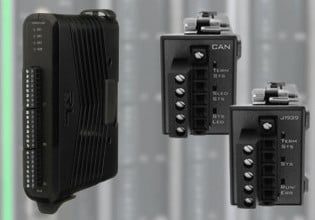Protocols for Industrial Remote Monitoring
Dive into why protocols are essential in industrial remote monitoring along with the most common types of open protocols seen in facilities.
Protocols are a set of rules developed, agreed upon, and implemented for remote monitoring. Protocols for remote monitoring define communication rules in every device and system involved in the monitoring. Each part or system must follow the same protocol because communication medium and data type change at every stage.
In industrial remote monitoring, protocols are implemented at the gateway level. The communication gateway provides an interface to different field devices, such as sensors, and makes them readable for the remote monitoring system.
The field sensor's data format is entirely different from the data transmission format. To make sensor data meaningful for monitoring, they are connected to the gateway and then to the cloud for further analytics and processing.
Importance of Protocols in Industrial Remote Monitoring
Manufacturers don't need to follow universally accepted protocols. Companies have the option of developing protocols specific to their company. However, manufacturers often avoid this and tend to follow universally accepted protocols.

Figure 1. Protocols keep the flow of data moving toward the relevant engineer. Image used courtesy of Siemens
Protocols are essential and advantageous in the following ways.
Interoperability
Protocols allow the user to install the equipment and system from a different manufacturer in a single monitoring system. It will enable communication and interface between the devices of other manufacturers.
If protocols are not followed, it can limit the device replacement options to the original manufacturer. The restriction becomes very critical when the equipment has become absolute, and replacement is the only option. In such a scenario, all equipment and devices need replacement, causing an increase in installation, configuration, and operation costs.
Cost-effectiveness
Universally accepted protocols create competition among the manufacturers, and they may produce equipment at less cost with full benefits.
Using universally accepted protocols also reduces installation costs, as the wiring and other supporting infrastructure remain the same. The in-house team can replace the device without technical expertise from the manufacturer and can efficiently handle the maintenance.
Interoperability of protocols among devices creates workable and practical knowledge about the device, which benefits the user, as the user is not dependent upon the manufacturer for maintenance requirements.
Fair Competition
Interoperability of protocols creates fair competition between manufacturers and suppliers. The playing field is not limited to lack of technical expertise, and they can have more options in terms of market share.
Users also benefit from taking advantage of the many options available in the market. They can select based on price, if that is necessary. They also benefit from customer support from the manufacturer and suppliers.
Standard Industrial Protocols Used in Remote Monitoring
There are many industrial protocols for remote monitoring. Each protocol serves different types of applications.
EtherNet / IP
EtherNet/IP protocol is a universal interoperable standard that has seen years of successful applications in an industrial environment. It is fast and can withstand noise problems common to many industries.
EtherNet/IP protocol is on standard Ethernet-based technology, and it uses Ethernet and Transport Control Protocol (TCP/IP). The international standard for EtherNet/IP is IEEE 802.3.
To represent the data on EtherNet/IP, it consists of two types of values. One consists of strings indicating the value, and the other characterizes information necessary for sending and receiving the data. All the devices are connected at the same level of authority and can send or receive data on the network.
EtherNet/IP is generally straightforward, but it can become tricky when many devices try to communicate simultaneously. This condition can overload the network and impart delay in sending or receiving the data. This becomes difficult for time-dependent communication.
EtherCAT
EtherCAT standards were developed by Beckhoff and are characterized by faster and more straightforward communication than Ethernet/IP. The international standard for EtherCAT is IEC 61158.

Figure 2. EtherCAT’s newest technology, EtherCAT G. Image used courtesy of Beckhoff
Communication in EtherCAT is initiated by one device. The client drive (formerly "master drive") sends the data frame onto the network, which travels through the nodes. Every node receives the data frame and extracts the data intended for that particular node, while the data frame is still moving onto the network. After receiving the data, it adds any required data into the same data frame, and this data frame then travels back to the client drive. All this data extraction and addition takes place while the data frame is moving.
This single data frame increases bandwidth utilization for a given function. This also eliminates the need for any additional microprocessor in the client drive as it is the only one able to handle the data frame. Compare this to Ethernet/IP, where more than one node is communicating simultaneously. Due to this property, there are no switches required in EtherCAT. All these factors contribute to increasing speed, performance, simplicity, and cost-effectiveness.
Modbus
Modbus is an open remote communication protocol created by Modicon, now Schneider Electric. Modbus is one of the most common protocols and connects electronic devices. Electronic and instrumentation systems such as PLCs, HMIs, and VFDs use the Modbus, where the central controller is responsible for collecting necessary data from the field devices.

Figure 3. Modbus client/server flowchart.
Modbus uses both serial and Ethernet lines to network with other devices. The serial version is Modbus RTU and Modbus ASCII, while the Ethernet version is called Modbus TCP.
Modbus works according to the client/server (formerly "master/slave") network system. It means that there must be at least one client device in the network, and all others are servers. The server devices are dependent on the instructions from the Client device to read data from the server and similarly write data to the server.
The Modbus protocol is commonly used to monitor building management systems and equipment or machines using automation systems, such as production machines in a manufacturing industry.
EtherNet/IP, EtherCAT, and Modbus are a few forms of standard open protocols for industrial remote monitoring. A facility may choose to use an open standard protocol versus one specific to a supplier due to interoperability, cost-effectiveness, and competitive fairness.







Nice article, thanks!
As for Ethernet/IP: “EtherNet/IP protocol is a universal interoperable standard that has seen years of successful applications in an industrial environment.”
Well, this is only partly true. In fact, the most important vendor (Rockwell) uses proprietary extensions to Ethernet/IP (having in the past change the interface).
More details, references (and speculations why 😊 ) can be read in “The theory versus practice” chapter of my blog:
https://d2000.ipesoft.com/blog/meet-the-most-widespread-communication-protocol-in-us
As for Modbus: though being one of the most widely used protocols (due to its simplicity), it lacks a lot of features and provides a lot of space for making errors. Therefore there is a lot of problems with various “mutations” of this protocol, resulting in a lot of complications. More details can be read in my blog: https://d2000.ipesoft.com/blog/communication-modbus-protocol
From the point of design, openness, and interoperability, BACnet protocol (used for building automation) is superior to both Modbus and Ethernet/IP. Using ASN.1 syntax and encoding, arbitrary values (even complicated structures) can be exchanged between both parties.
https://d2000.ipesoft.com/blog/communication-bacnet
https://d2000.ipesoft.com/blog/communication-bacnet-part-2
https://d2000.ipesoft.com/blog/communication-bacnet-part-3
Of course, it’s an older standard, so it lacks encryption and universality of OPC UA, which is a relatively new standard with an ambition to replace a lot of private protocols (we work with Simatic S7-1200/1500, B&R PLCs, and others, which already implement it - whether as a pair option [Simatic] or by default [B&R]).